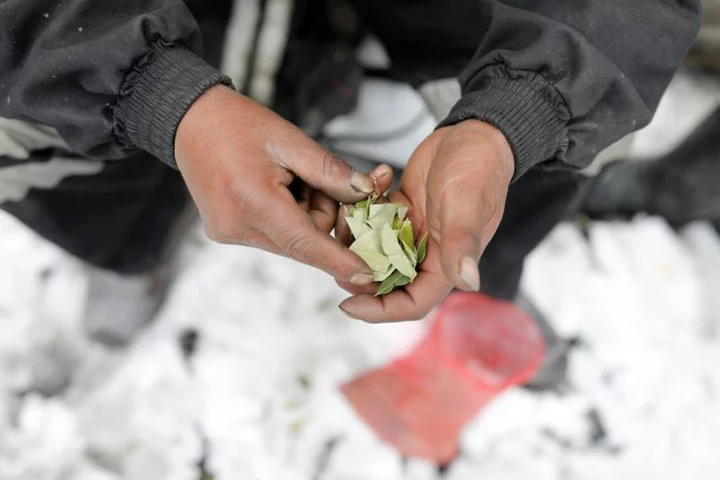By Marco Aquino
LIMA (Reuters) -Peru's land dedicated to the cultivation of coca leaves grew 18% to record highs in 2022, the government anti-drug chief said Monday, notably in protected lands and indigenous Amazon villages close to the borders with Brazil and Colombia.
Coca leaves, the raw ingredient for cocaine, is traditionally chewed for energy or as an antidote for altitude sickness and is legal for such uses.
However, analysts and government officials estimate some 90% of Peru's crop is used in the illicit drug trade and its cultivation has been growing yearly since 2015.
Coca covered 95,008 hectares (367 square miles) last year, said Carlos Figueroa, president of the national DEVIDA drugs commission, marking what analysts deem the largest figure in at least two decades.
"Now the damage is even more powerful, because it includes environmental crimes in forests, in protected areas and with greater incidence in indigenous or native communities," he told a press conference.
Figueroa said illicit coca cultivation on indigenous territories had almost doubled since 2020, reaching 18,674 hectares last year. There was worrying expansion along the borders with Colombia and Brazil, where international drug traffickers operate, he said.
Peru and Colombia are the world's largest producers of both coca leaf and cocaine, according to the United Nations. Figueroa estimated that current coca crops could have produced some 870 tons of cocaine in 2022.
Peru's largest area of coca cultivation and cocaine production remains the Valley of the Apurímac, Ene and Mantaro rivers, or VRAEM, accounting for some 35,709 hectares, Figueroa said. The area of mountains and jungle is roughly the size of Puerto Rico at the center of the Andean country.
Drug traffickers in this area work in alliance with remnants of the Shining Path rebel group, according to police.
At the Amazon border regions of Ucayali and Loreto, cultivation advanced 43% and 34% respectively, Figueroa said.
Drug traffickers along the border are linked to dissidents from Colombia's FARC guerrilla group and the Red Command, deemed one of Brazil's largest criminal organizations, he added.
Clandestine landing strips for drug planes have increased despite police efforts, he added, noting air routes make an easy and important exit for remote operations.
In a separate conference on Monday, Luisa Sterponi, a coordinator at the U.N.'s drugs office, said Peruvian cocaine is mostly transported to Bolivia and Brazil, then shipped mainly to Europe and Oceania.
Peru has been in talks with the United States for years hoping it will lend "non-lethal" support to intercept planes carrying illegal drugs.
Washington suspended its prior support in 2001 when Peru's Air Force shot down a plane mistakenly thought to be carrying drugs, killing two U.S. citizens.
(Reporting by Marco Aquino; Writing by Sarah Morland; Editing by Richard Chang and Grant McCool)









